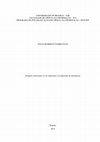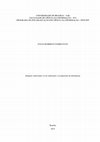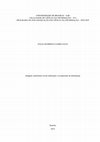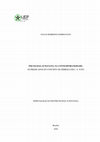Papers by Paulo Roberto Gomes Pato
O trabalho evidencia as implicacoes para o processo de indexacao de imagens que decorrem da relac... more O trabalho evidencia as implicacoes para o processo de indexacao de imagens que decorrem da relacao entre o conhecimento do indexador, o referente fotografico e o que denominamos referentes internos do indexador. Mostra que a indexacao pelo referente fotografico e insuficiente para revelar o conteudo informacional das fotografias. Conclui que a fotografia nao e icone, simbolo ou indice da realidade, e que a leitura e a indexacao da imagem fotografica devem considerar a presenca simultânea dessas tres categorias semioticas.

We propose in this thesis an approach to view still images providing the basis for organizing the... more We propose in this thesis an approach to view still images providing the basis for organizing the imagery information. It expands the dominant model that organizes the imagery information only according to the description of figurative icons on the images. Reading images implies perceive the presence and the characteristic operation of the three main semiotic signs: the icon, index and symbol. Our proposed reading concludes that indexing should have four different entries for keywords. The first three according to the characteristics of each type of sign. Together, they represent the predicates of a concept. The last entry shows the result of semiosis, the (s) concept (s) or matter (s) of the image. Besides highlighting the predicates (s) concept (s) of each image, the approach avoids that, due to the single entry terms, free indexing feature of folksonomic type predominates the presence of icons, signs that represent figured material objects the images and are the first to be identified in any reading process. Organized and tabulated in different entries, the keywords associated with the presence and operation of the three types of signs and summarized in (s) concept (s) extend the availability of existing information on the images of a system of organizing information. Depending on the polysemic characteristic of images, the read and indexing processes should consider the application domain of the material analyzed
Zenodo (CERN European Organization for Nuclear Research), Dec 28, 2022
Baseado nos conceitos de Umwelt e Ungebung, que ratifica o de "função da Arte", de Ernst Fisher, ... more Baseado nos conceitos de Umwelt e Ungebung, que ratifica o de "função da Arte", de Ernst Fisher, e o de "objetivo final da Arte", de Guyau, o artigo discute o fenômeno da conexão entre tecnologia, histórias narradas pelo cinema de animação, a mente e os sentimentos humanos. Analisamos o curta-metragem de animação 2D "The Little Matchgirl", dos Estúdios Disney, por uma perspectiva formalista e sociológica, visando esclarecer a relação entre Arte/mente/sentimento e como a conexão entre esses elementos pode atuar como possível gatilho de conscientização e mobilização social. Ponderamos que questões humanas básicas, universais, perpassam a aplicação e uso de qualquer tecnologia a serviço da Arte, e não é tecnologia em si que conta, mas as possibilidades expressivas que ela proporciona aos artistas.
Este artigo apresenta metodologia para a leitura e indexacao de imagens. Contrapomos a proposta a... more Este artigo apresenta metodologia para a leitura e indexacao de imagens. Contrapomos a proposta ao paradigma vigente que enfatiza o processo descritivo e nominativo dos icones figurados nas imagens. A semiotica de Peirce fundamenta o trabalho. Para organizar a informacao imagetica com eficacia, e imprescindivel considerar as tres principais categorias semioticas de signo, o icone, o indice e o simbolo, pois os significados emergem apenas em funcao da semiose, a acao e relacao entre esses signos. Para indexar imagens, propomos quatro diferentes entradas de termos. Uma para cada categoria de signos e a quarta para o assunto da imagem. O procedimento mostra que as tres categorias de signos formam os predicados do conceito da imagem, representado pelo assunto.

Propomos nesta tese uma abordagem para ler imagens estáticas que forneça as bases para organizar ... more Propomos nesta tese uma abordagem para ler imagens estáticas que forneça as bases para organizar a informação imagética. Ela amplia o modelo dominante que organiza a informação imagética apenas em função da descrição dos ícones figurados nas imagens. A leitura de imagens implica em perceber a presença e o funcionamento característico dos três principais signos semióticos: o ícone, o índice e o símbolo. Nossa proposta de leitura conclui que a indexação deve ter quatro diferentes entradas para palavras-chave. As três primeiras de acordo com as características de cada um dos tipos de signos. Juntas, representam os predicados de um conceito. A última entrada apresenta o resultado da semiose, o(s) conceito(s) ou assunto(s) da imagem. Além de evidenciar os predicados do(s) conceito(s) de cada imagem, a abordagem evita que, em função da entrada única de termos, característica da indexação livre do tipo folksonômica, predomine a presença dos ícones, signos que representam objetos materiais ...
ÍCONE, ÍNDICE E SÍMBOLO, FUNDAMENTOS PARA LER E ORGANIZAR A INFORMAÇÃO EM IMAGENS, 2014
This paper presents a methodology for reading and indexing of images. We oppose
the proposal of ... more This paper presents a methodology for reading and indexing of images. We oppose
the proposal of the current paradigm that emphasizes descriptive and nominative process of
icons on the images. The Peirce’s semiotics based work. To organize imagery information
effectively, it is essential to consider the three main categories of semiotic sign, icon, index and
symbol, since the meanings emerge only in terms of semiosis, the action and the relationship
between these signs. To index images, we propose four different entries of terms. One for each
category of signs and the fourth to the subject of the image. The procedure shows that the three
categories of signs form the predicates of the concept image, represented by the subject.

Propomos nesta tese uma abordagem para ler imagens estáticas que forneça as bases para organizar ... more Propomos nesta tese uma abordagem para ler imagens estáticas que forneça as bases para organizar a informação imagética. Ela amplia o modelo dominante que organiza a informação imagética apenas em função da descrição dos ícones figurados nas imagens. A leitura de imagens implica em perceber a presença e o funcionamento característico dos três principais signos semióticos: o ícone, o índice e o símbolo. Nossa proposta de leitura conclui que a indexação deve ter quatro diferentes entradas para palavras-chave. As três primeiras de acordo com as características de cada um dos tipos de signos. Juntas, representam os predicados de um conceito. A última entrada apresenta o resultado da semiose, o(s) conceito(s) ou assunto(s) da imagem. Além de evidenciar os predicados do(s) conceito(s) de cada imagem, a abordagem evita que, em função da entrada única de termos, característica da indexação livre do tipo folksonômica, predomine a presença dos ícones, signos que representam objetos materiais figurados nas imagens e que são os primeiros a serem identificados em qualquer processo de leitura. Organizadas e tabuladas em diferentes entradas, as palavras-chave decorrentes da presença e funcionamento dos três tipos de signos e sintetizadas no(s) conceito(s) ampliam a disponibilidade de informação existente nas imagens de um sistema de organização da informação. Em função da característica polissêmica das imagens, os processos de leitura e indexação devem considerar o domínio de aplicação do material analisado.
We propose in this thesis an approach to view still images providing the basis for organizing the imagery information. It expands the dominant model that organizes the imagery information only according to the description of figurative icons on the images. Reading images implies perceive the presence and the characteristic operation of the three main semiotic signs: the icon, index and symbol. Our proposed reading concludes that indexing should have four different entries for keywords. The first three according to the characteristics of each type of sign. Together, they represent the predicates of a concept. The last entry shows the result of semiosis, the (s) concept (s) or matter (s) of the image. Besides highlighting the predicates (s) concept (s) of each image, the approach avoids that, due to the single entry terms, free indexing feature of folksonomic type predominates the presence of icons, signs that represent figured material objects the images and are the first to be identified in any reading process. Organized and tabulated in different entries, the keywords associated with the presence and operation of the three types of signs and summarized in (s) concept (s) extend the availability of existing information on the images of a system of organizing information. Depending on the polysemic characteristic of images, the read and indexing processes should consider the application domain of the material analyzed.
Este trabalho evidencia as implicações para o processo de indexação de imagens que decorrem da re... more Este trabalho evidencia as implicações para o processo de indexação de imagens que decorrem da relação entre o conhecimento do indexador, o referente fotográfico e o que denominamos referentes internos do indexador. Mostra que a indexação pelo referente fotográfico é insuficiente para revelar o conteúdo informacional das fotografias. Conclui que a fotografia não é ícone, símbolo ou índice da realidade, e que a leitura e a indexação da imagem fotográfica devem considerar a presença simultânea dessas três categorias semióticas. Palavras-chave: indexação; fotografia; semiótica; referente interno.

É fundamental para a Ciência definir claramente os conceitos utilizados nas diversas
disciplinas.... more É fundamental para a Ciência definir claramente os conceitos utilizados nas diversas
disciplinas. O objetivo deste estudo é extrair os predicados do conceito de símbolo a partir dos enunciados sobre o termo elaborados por C.G. Jung ao longo de sua obra. Utiliza como referência metodológica a Teoria do Conceito e as perspectivas Pragmáticas de William James e de Charles Sanders Peirce. Conclui que o símbolo junguiano apresenta dois aspectos conceituais: um universal e geral, com base nos arquétipos, e outro polissêmico e individual, fruto das imagens arquetípicas, refletindo respectivamente as visões pragmáticas de Peirce e James. Apresenta os principais enunciados de Jung que mostram os predicados do conceito de símbolo, de viés polissêmico e individual, e extrai os principais, com os quais elabora a
definição conceitual de símbolo, segundo o pensamento de Jung.
PALAVRAS-CHAVE: símbolo; psicologia; conceito; semiótica; pragmática
... Marcius José Manosso CuritibaPR (DONALD, Pato. nº 2319. junho de 2005. p. 25. carta do leitor... more ... Marcius José Manosso CuritibaPR (DONALD, Pato. nº 2319. junho de 2005. p. 25. carta do leitor). Page 6. RESUMO Durante muitos anos, as Histórias em Quadrinhos foram acusadas de prejudicar o rendimento escolar dos jovens alunos. ...
A linguagem das Histórias em Quadrinhos como ferramenta didática, 2002
A monografia de especialização do curso Formação em EAD apresenta aos professores dos ensinos Fun... more A monografia de especialização do curso Formação em EAD apresenta aos professores dos ensinos Fundamental e Médio a linguagem das Histórias em Quadrinhos na forma de um curso específico para ser utilizado em sala de aula como apoio ao ensino das disciplinas curriculares. Inicialmente justificamos a metodologia do curso, particularmente tendo em vista sua aplicação no contexto da EAD, para em seguida desenvolvê-lo utilizando linguagem simples e objetiva.
Este artigo aborda a problemática referente ao tratamento de registros fotográficos não orgânicos... more Este artigo aborda a problemática referente ao tratamento de registros fotográficos não orgânicos custodiados por Centros de Documentação. Elenca as diretrizes básicas fundamentais para a caracterização de documento arquivístico. Propõe uma leitura de imagens baseada no conceito de índice elaborado por Peirce.
This article discusses how the Concept Theory of Dahlberg can be applied in opinion surveys about... more This article discusses how the Concept Theory of Dahlberg can be applied in opinion surveys about corporate image. The starting point was the application of national survey to evaluate the image of the National Electric Energy Agency (ANEEL). Because of difficulty in objectively measure "corporate image", due to the high degree of subjectivity inherent in this expression, we chose to use the Concept Theory of Dahlberg. According to the author, the makings of a concept are the terms that underlie a given concept. In this sense, the institution's values and their definitions, contained in the Agency's strategic planning function as predicates of the concept of corporate image ANEEL.
This paper draws a parallel between the proposed Dubois on the historical stages of understanding... more This paper draws a parallel between the proposed Dubois on the historical stages of understanding modes of the photographic image, linked to the index, the icon and the semiotic symbol, and the use of images in advertising. Changes in consumer conditions have been accompanied by changes in the use of advertising images. The initial objective of the images use was to show the object to be consumed, embodied in his right and real icon. It was later added symbolic value to the goods. Currently, advertising demand, through the indices imply the pleasure of the enjoyment of the object.
Discutimos o referente da fotografia pelo viés do receptor. O foco é a troca social de signos sub... more Discutimos o referente da fotografia pelo viés do receptor. O foco é a troca social de signos subjacente à recepção e como o receptor analisa a imagem fotográfica. Apresentamos o processo de construção cognitiva da criança, segundo Piaget, e sua relação com as categorias semióticas de ícone, índice e símbolo conforme Peirce. Mostramos que as discussões sobre o caráter da fotografia -icônico, simbólico ou indicial -pouco contribuem para a adoção de uma perspectiva de análise de imagens como objetos sociais e informacionais. Destacamos a importância do que designamos referentes internos para o processo de leitura de imagens. Palavras-chave: semiótica; fotografia; referente; cognição.








Uploads
Papers by Paulo Roberto Gomes Pato
the proposal of the current paradigm that emphasizes descriptive and nominative process of
icons on the images. The Peirce’s semiotics based work. To organize imagery information
effectively, it is essential to consider the three main categories of semiotic sign, icon, index and
symbol, since the meanings emerge only in terms of semiosis, the action and the relationship
between these signs. To index images, we propose four different entries of terms. One for each
category of signs and the fourth to the subject of the image. The procedure shows that the three
categories of signs form the predicates of the concept image, represented by the subject.
We propose in this thesis an approach to view still images providing the basis for organizing the imagery information. It expands the dominant model that organizes the imagery information only according to the description of figurative icons on the images. Reading images implies perceive the presence and the characteristic operation of the three main semiotic signs: the icon, index and symbol. Our proposed reading concludes that indexing should have four different entries for keywords. The first three according to the characteristics of each type of sign. Together, they represent the predicates of a concept. The last entry shows the result of semiosis, the (s) concept (s) or matter (s) of the image. Besides highlighting the predicates (s) concept (s) of each image, the approach avoids that, due to the single entry terms, free indexing feature of folksonomic type predominates the presence of icons, signs that represent figured material objects the images and are the first to be identified in any reading process. Organized and tabulated in different entries, the keywords associated with the presence and operation of the three types of signs and summarized in (s) concept (s) extend the availability of existing information on the images of a system of organizing information. Depending on the polysemic characteristic of images, the read and indexing processes should consider the application domain of the material analyzed.
disciplinas. O objetivo deste estudo é extrair os predicados do conceito de símbolo a partir dos enunciados sobre o termo elaborados por C.G. Jung ao longo de sua obra. Utiliza como referência metodológica a Teoria do Conceito e as perspectivas Pragmáticas de William James e de Charles Sanders Peirce. Conclui que o símbolo junguiano apresenta dois aspectos conceituais: um universal e geral, com base nos arquétipos, e outro polissêmico e individual, fruto das imagens arquetípicas, refletindo respectivamente as visões pragmáticas de Peirce e James. Apresenta os principais enunciados de Jung que mostram os predicados do conceito de símbolo, de viés polissêmico e individual, e extrai os principais, com os quais elabora a
definição conceitual de símbolo, segundo o pensamento de Jung.
PALAVRAS-CHAVE: símbolo; psicologia; conceito; semiótica; pragmática
the proposal of the current paradigm that emphasizes descriptive and nominative process of
icons on the images. The Peirce’s semiotics based work. To organize imagery information
effectively, it is essential to consider the three main categories of semiotic sign, icon, index and
symbol, since the meanings emerge only in terms of semiosis, the action and the relationship
between these signs. To index images, we propose four different entries of terms. One for each
category of signs and the fourth to the subject of the image. The procedure shows that the three
categories of signs form the predicates of the concept image, represented by the subject.
We propose in this thesis an approach to view still images providing the basis for organizing the imagery information. It expands the dominant model that organizes the imagery information only according to the description of figurative icons on the images. Reading images implies perceive the presence and the characteristic operation of the three main semiotic signs: the icon, index and symbol. Our proposed reading concludes that indexing should have four different entries for keywords. The first three according to the characteristics of each type of sign. Together, they represent the predicates of a concept. The last entry shows the result of semiosis, the (s) concept (s) or matter (s) of the image. Besides highlighting the predicates (s) concept (s) of each image, the approach avoids that, due to the single entry terms, free indexing feature of folksonomic type predominates the presence of icons, signs that represent figured material objects the images and are the first to be identified in any reading process. Organized and tabulated in different entries, the keywords associated with the presence and operation of the three types of signs and summarized in (s) concept (s) extend the availability of existing information on the images of a system of organizing information. Depending on the polysemic characteristic of images, the read and indexing processes should consider the application domain of the material analyzed.
disciplinas. O objetivo deste estudo é extrair os predicados do conceito de símbolo a partir dos enunciados sobre o termo elaborados por C.G. Jung ao longo de sua obra. Utiliza como referência metodológica a Teoria do Conceito e as perspectivas Pragmáticas de William James e de Charles Sanders Peirce. Conclui que o símbolo junguiano apresenta dois aspectos conceituais: um universal e geral, com base nos arquétipos, e outro polissêmico e individual, fruto das imagens arquetípicas, refletindo respectivamente as visões pragmáticas de Peirce e James. Apresenta os principais enunciados de Jung que mostram os predicados do conceito de símbolo, de viés polissêmico e individual, e extrai os principais, com os quais elabora a
definição conceitual de símbolo, segundo o pensamento de Jung.
PALAVRAS-CHAVE: símbolo; psicologia; conceito; semiótica; pragmática